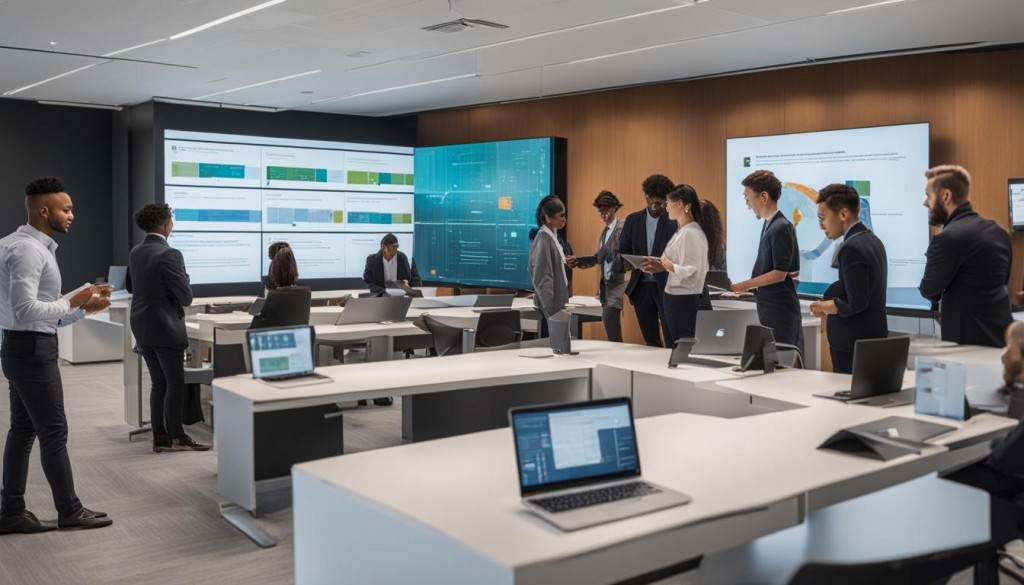July 28, 2025
With more than 20 years of consulting expertise, Sinfony has tackled a major challenge in digital transformation : optimize and accelerate regulatory training through digital technology. By collaborating with the biggest names in the sector, we have developed a unique catalog of digital training courses, allowing your company to train its staff more quickly, efficiently and at a lower cost.
Sinfony, with its specific expertise in the simplification and effectiveness of training through digital technology, is in an ideal position to revolutionize onboarding through microlearning and blended learning.
Microlearning is a teaching method that consists in offering short learning sessions, generally from 5 minutes maximum, available online.
Each session aims to fill a specific need of the learner and can be viewed at any time and in the order chosen. Microlearning content is often presented in the form of “learning gems”, mini-activities that are independent of each other.
https://www.youtube.com/watch?v=Ueifej9Cikg
“Microlearning is an ideal solution for professionals looking for a way efficient and fast to learn new skills. With short training sessions, learners can focus on Learning nuggets specific ones and apply them immediately in their daily work.”
Microlearning has grown in popularity due to its flexibility And of her ease of access. Learners can access microlearning sessions Anytime and anywhere, from their computer, smartphone or tablet. This approach is particularly suitable for professionals who have busy schedules and can devote a few minutes a day to learning.
Advantages Disadvantages
Microlearning offers numerous advantages for corporate training.
It meets the constraints of a lack of time for employees by offering short and targeted modules. With this approach, learners can learn instantly, anytime, anywhere. La speed of learning is thus favored, allowing employees to acquire new skills more quickly.
Microlearning also aims to individualize training by adapting the content to the specific needs of each learner. This makes it possible to personalize the training path and to optimize the effectiveness of learning. Learners are then more engaged, because they receive content that is relevant and adapted to their needs, which leads to 50% increase in engagement. This approach also favors the Increase in skills employees, allowing them to acquire the necessary knowledge in an effective and targeted manner.
In addition, microlearning can be used to boost a blended learning training system.
By combining microlearning with other training methods, such as face-to-face sessions, learners benefit from comprehensive and balanced training. This combination makes it possible to promote memory anchoring, by offering opportunities for the practical application of the knowledge acquired. Learners thus have the opportunity to put their skills into practice and to permanently anchor their learning in their professional daily lives.

Benefits of microlearning for corporate training • Speed of learning • Individualization of training • Increased learner engagement • Increase in skills faster • Boosting blended learning • Strengthened memory anchoring
Learning through microlearning offers numerous advantages. It allows you to personalize the training path according to the specific needs of learners, thus promoting a more adapted and engaging learning experience.
With microlearning, learners benefit from a great flexibility. They can learn whenever and wherever they want, whether from their desk, on the go, or even from home. This flexibility brings real freedom and autonomy in the learning process.
THELearner engagement is considerably strengthened thanks to microlearning. The content offered is dynamic, interactive and often presented in the form of micro-lessons, which facilitates the assimilation of knowledge and stimulates the interest of learners.
In addition to the educational benefits, microlearning also makes it possible to make significant savings. By eliminating the travel and accommodation costs associated with traditional face-to-face training, businesses can significantly reduce their training costs.
Finally, the progress monitoring of learners is greatly facilitated thanks to integrated assessment tools. Learners can measure their own progress, while trainers and training managers have access to accurate data on individual and collective performances.
Benefits of learning through microlearning Personalization Of training path Flexibility in training times and locations Strengthening learner engagement Cost reduction Precise monitoring of learners' progress
While microlearning has many benefits, it should be noted that there are some limitations to this training approach. These limitations can make it difficult to adapt to complex courses that require more learning time. Microlearning is generally designed to provide short, focused learning sessions, which can limit its relevance when it comes to covering complex topics in depth.
Another potential microlearning challenge is Feeling isolated that it can cause in learners. Since learners take courses alone in front of their screen, this can lead to a lack of interaction, exchange, and sharing with other learners or trainers. This feeling of isolation can decrease learners' motivation and engagement.
To overcome these limitations, it is important to create moments of exchange and interactivity at a distance within microlearning programs. This can be done by integrating online chat sessions, sharing forums, or group activities. In this way, learners will be able to interact with peers, ask questions, share experiences, and benefit from a more rewarding and collaborative learning experience.
There are undeniable benefits to microlearning, but it is essential to recognize its limitations and find ways to overcome them in order to ensure an optimal learning experience for all learners.
Limits of microlearning Mitigation strategies Difficulty adapting to complex training courses Integrate complementary modules or face-to-face training sessions to cover more complex aspects Learner isolation Integrate online discussion sessions, sharing forums, or group activities to promote interaction and exchange between learners
Blended learning, also known as blended training, is an innovative pedagogical approach that combines different learning modalities to offer a complete and balanced experience. This training method takes advantage of the advantages of each modality, combining the best of e-learning and face-to-face training.
Blended learning uses new digital technologies, such as digital platforms elearning, to provide online training in a flexible and accessible way. Learners can take courses at their own pace, using a variety of digital resources such as videos, interactive modules, and online quizzes.
However, blended learning is not limited to online learning. It also includes face-to-face training sessions, which promote exchanges and interaction between learners. Face-to-face sessions can take the form of seminars, practical workshops, or demonstration sessions, offering opportunities for collaborative learning and applying knowledge.
This hybrid approach combines the flexibility and accessibility of e-learning with the benefits of face-to-face training, such as social interaction, live feedback, and group discussions. Blended learning thus offers a richer and more engaging learning experience for learners.

Blended learning has become increasingly popular in many sectors because it can meet the varied needs of learners. It offers increased flexibility, allowing learners to manage their schedule and choose the place and time that works best for them to learn.
This approach can be used in many contexts, such as vocational training, continuing education, university education, and even corporate employee training. Blended learning can be adapted to different skill levels and areas of learning, offering a versatile and effective solution for training.
In summary, blended learning is a training approach that combines e-learning and face-to-face training to provide a complete and balanced learning experience. This method makes it possible to take advantage of the advantages of both modalities, thus offering increased flexibility, better social interaction and a rewarding learning experience for learners.
Blended learning offers many benefits similar to microlearning. It allows a personalizing training courses, great flexibility in schedules and places of training, a learner engagement reinforced through interactive content, a cost reduction of training and accurate monitoring of learners' progress. In addition, blended learning promotes interactions between learners, which can increase learning effectiveness.
Advantages of blended learning Personalization of training courses Great flexibility in training times and locations Learner engagement strengthened through interactive content Cost reduction of training Precise monitoring of learners' progress Encouraging interactions between learners
Microlearning and blended learning are two complementary pedagogical approaches that can be combined to create blended and effective learning paths.
Microlearning, with its approach based on short learning sessions, can be integrated into the blended learning framework to offer learners specific and targeted online modules.
With microlearning, learners can learn at their own pace, anytime, anywhere. Short and targeted modules make it possible to quickly transmit key knowledge, while face-to-face blended learning training sessions promote exchanges and interaction between learners.
By integrating microlearning into blended learning, businesses can capitalize on the benefits of both approaches: the flexibility and personalization of microlearning, as well as the face-to-face interactions of blended learning. This makes it possible to optimize the effectiveness of training by offering balanced and engaging learning experiences.
For example, in a blended learning course, learners can take online microlearning modules to acquire basic knowledge and then participate in face-to-face sessions to reinforce that knowledge and put it into practice. This combination makes it possible to adapt training to the specific needs of learners while promoting engagement and interaction.
In summary, integrating microlearning into blended learning offers numerous benefits, including flexibility, personalization, and learner engagement. It is a comprehensive pedagogical approach that makes it possible to make the most of both methods for effective training adapted to the needs of each learner.
Collaborative learning plays a crucial role in microlearning and blended learning. By promoting exchange and knowledge sharing between learners, it helps create a learning culture within the organization.
Collaborative learning in microlearning offers numerous benefits. It allows learners to share their knowledge and skills, thus promoting learning in the workplace. By capitalizing on the expertise available internally, learners can develop practical and concrete skills.
Collaborative learning also reinforces learner engagement. By encouraging exchanges and interactions, it stimulates learners' motivation and promotes their active participation in the learning process.
Through collaborative learning, learners can learn from each other, ask questions, share experiences, and solve problems together. This promotes a more dynamic approach to learning, where interaction and collaboration are at the heart of training.
By integrating collaborative learning into microlearning and blended learning, organizations can fully exploit the potential of their learners and encourage the acquisition of skills in a stimulating and interactive environment.
Benefits of collaborative learning Examples of collaborative practices Strengthens learner engagement Strengthens learner engagement Group projects Promotes work-based learning Discussion forums Enables knowledge sharing Collaborative case studies Encourage problem solving Brainstorming sessions
Let's say that in a blended learning program, learners participate in online modules followed by in-person sessions. During face-to-face sessions, learners are encouraged to work together on concrete projects, share knowledge, and solve problems as a group.
For example, they could be divided into teams and given a specific practical case to solve. By working together and sharing skills and perspectives, learners will be in a position to develop innovative solutions and deepen their understanding of the subject.
This type of collaborative learning not only strengthens learners' technical skills, but also develops their social skills and their ability to work in a team.
Adaptive learning represents a major advance in the field of digital training. This approach uses artificial intelligence and machine learning methods to offer personalized training paths to learners, based on their specific needs.
In the context of blended learning, which combines different training modalities online and in person, adaptive learning makes it possible to optimize the learning experience by adapting to the preferences and pace of each learner. Thus, the contents and activities offered may vary according to the needs and abilities of each person.
A journey ofAdaptive learning in blended learning can integrate multimedia interactive, such as videos, simulations, or practical exercises, to make learning more engaging and challenging. This approach promotes a personalized and immersive learning experience that allows learners to better assimilate knowledge and apply it in their professional context.
The major advantage ofAdaptive learning in blended learning is its ability to adjust the level of difficulty and the content of training courses according to the progress of each learner. Thus, those who master certain concepts more quickly can advance more quickly, while those who encounter difficulties may benefit from additional resources or a different pedagogical approach.
In summary, the implementation of an adaptive learning path in blended learning offers multiple advantages, such as the personalization of training, the integration of interactive multimedia content, the adaptation to the individual needs of learners and the possibility of monitoring their progress accurately. This approach represents a real innovation in the field of digital training and opens up new perspectives for effective and personalized learning.
Benefits of adaptive learning in blended learning Limits of adaptive learning in blended learning
Thus, the implementation of an adaptive learning path in blended learning represents a promising solution to offer an optimal and personalized learning experience to learners, taking advantage of the advantages of both approaches.
In the field of microlearning and blended learning, the application of knowledge plays a crucial role. The objective of these approaches is to transform the knowledge acquired into concrete skills, directly applicable in the professional environment.
Microlearning offers learners the opportunity to challenge themselves through scenarios and simulations. By offering game mechanisms, it promotes interaction and emulation between learners. These fun activities encourage the practical application of knowledge and strengthen learners' engagement.
In the context of blended learning, knowledge is also applied through learning-based actions. By combining online and face-to-face training sessions, learners have the opportunity to put what they have learned into practice in real situations. This makes it possible to strengthen the knowledge retention and to promote better application in their daily work.
“Microlearning and blended learning offer unique opportunities to encourage the application of acquired knowledge. Through interactive activities, realistic scenarios and scenarios, learners are stimulated to use their knowledge in a concrete and practical way.” - Expert in digital training
Let's imagine a training course on first aid in business. Learners follow a microlearning module that introduces them to the different steps to take during an emergency situation. At the end of the module, they are challenged to put their knowledge into practice by responding to realistic scenarios.
These interactive activities allow learners to practice making quick decisions and applying their knowledge in real life situations. This reinforces their confidence and their ability to respond effectively in an emergency.
Let's take sales training as an example. Learners take part of the online training, where they learn sales techniques, the arguments to present to customers, etc. Then, they participate in face-to-face sessions where they have the opportunity to put their knowledge into practice during real situations with potential customers.
This combination of microlearning and blended learning reinforces the application of knowledge by providing opportunities for learners to apply their skills in an authentic environment. In this way, learners not only develop their knowledge but also their practical skills, which contributes to better retention and more effective application in the professional context.
Benefits of applying knowledge Examples of application activities Strengthens the knowledge retention Interactive scenarios, role playing Allows the acquisition of practical skills Real-life situations, guided practice Stimulates learners' engagement Games, challenges, competitions Improves the transferability of knowledge Concrete projects, case studies
The platforms of elearning play a key role in the implementation of microlearning and blended learning. They offer companies the tools they need to provide online training adapted to the specificities of these approaches.
To choose the e-learning platform that best suits your business, it is important to consider several criteria. First, make sure the platform offers personalization features. This will make it possible to create tailor-made training courses, according to the specific needs of each learner.
In addition, it is essential that the platform integrates tools for evaluating and monitoring learners' progress. This feature will make it possible to measure the effectiveness of the training courses and to adjust the content if necessary.
Finally, take into account the integration needs with your company's existing tools, such as HRIS (Human Resources Information System). A platform compatible with your existing systems will facilitate the management of training and the administration of learners.
To help you make the right choice, we have made a detailed comparison of the main e-learning platforms available on the market. Here are some of the characteristics to consider when making your selection:
Platform name Key Features Integrations Price Platform 1 Feature 1, Feature 1, Feature 1, Feature 2, Feature 3 Integration 1, Integration 2, Feature 1, Feature 2, Feature 3 Integration 1, Integration 1, Integration 2, Integration 3, Integration 3 Price 2, Integration 3 Price 2, Integration 3 Price 2 Platform 3 Feature 1, Feature 2, Feature 3 Integration 1, Integration 2, Integration 3 Price 3
This information will allow you to compare the different platforms and make an informed decision based on the specific needs of your business.
Choosing the right e-learning platform is essential to ensure the successful implementation of microlearning and blended learning in your business. An adapted platform will allow you to offer quality, personalized training courses in accordance with your company's training objectives.
Microlearning and blended learning play an increasingly crucial role in onboarding and corporate training. These approaches make it possible to optimize the integration of new employees by offering short training courses adapted to their specific needs.
Collaborative learning is also essential to promote the exchange and sharing of knowledge between learners. By encouraging collaboration, businesses can create a dynamic learning culture and strengthen learner engagement.
To fully exploit the benefits of microlearning and blended learning, it is crucial to choose the right e-learning platforms and to integrate them consistently into training programs. With more than 20 years of consulting expertise, at Sinfony, we support companies in their transition to digital transformation by offering personalized solutions. Contact us now to find out how we can help you improve your training programs and promote Increase in skills of your collaborators.
Des formations conçues par des experts métier, régulièrement mises à jour pour coller aux exigences terrain. Découvrez nos modules les plus suivis et les mieux notés par les professionnels.

Formation complète sur les Bonnes Pratiques de Fabrication (BPF) adaptée à votre profil professionnel dans l'industrie pharmaceutique et vétérinaire.

Maîtriser les techniques et les procédures essentielles.

Les procédures essentielles d'hygiène et de sécurité pour le personnel...